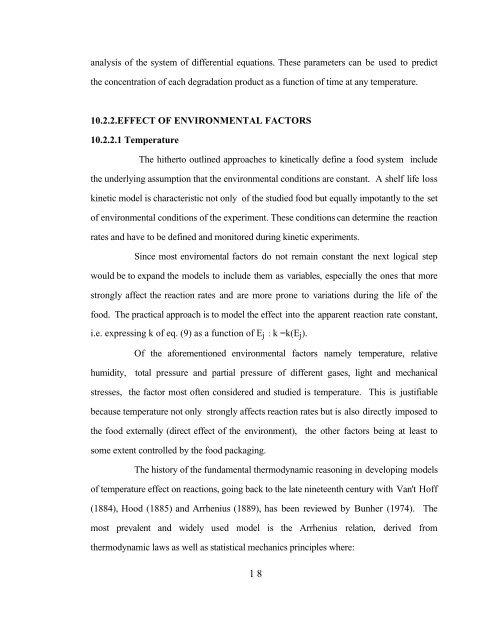the handbook of food engineering practice crc press chapter 10 ...
the handbook of food engineering practice crc press chapter 10 ...
the handbook of food engineering practice crc press chapter 10 ...
Create successful ePaper yourself
Turn your PDF publications into a flip-book with our unique Google optimized e-Paper software.
analysis <strong>of</strong> <strong>the</strong> system <strong>of</strong> differential equations. These parameters can be used to predict<br />
<strong>the</strong> concentration <strong>of</strong> each degradation product as a function <strong>of</strong> time at any temperature.<br />
<strong>10</strong>.2.2.EFFECT OF ENVIRONMENTAL FACTORS<br />
<strong>10</strong>.2.2.1 Temperature<br />
The hi<strong>the</strong>rto outlined approaches to kinetically define a <strong>food</strong> system include<br />
<strong>the</strong> underlying assumption that <strong>the</strong> environmental conditions are constant. A shelf life loss<br />
kinetic model is characteristic not only <strong>of</strong> <strong>the</strong> studied <strong>food</strong> but equally impotantly to <strong>the</strong> set<br />
<strong>of</strong> environmental conditions <strong>of</strong> <strong>the</strong> experiment. These conditions can determine <strong>the</strong> reaction<br />
rates and have to be defined and monitored during kinetic experiments.<br />
Since most enviromental factors do not remain constant <strong>the</strong> next logical step<br />
would be to expand <strong>the</strong> models to include <strong>the</strong>m as variables, especially <strong>the</strong> ones that more<br />
strongly affect <strong>the</strong> reaction rates and are more prone to variations during <strong>the</strong> life <strong>of</strong> <strong>the</strong><br />
<strong>food</strong>. The practical approach is to model <strong>the</strong> effect into <strong>the</strong> apparent reaction rate constant,<br />
i.e. ex<strong>press</strong>ing k <strong>of</strong> eq. (9) as a function <strong>of</strong> E j : k =k(E j ).<br />
Of <strong>the</strong> aforementioned environmental factors namely temperature, relative<br />
humidity, total <strong>press</strong>ure and partial <strong>press</strong>ure <strong>of</strong> different gases, light and mechanical<br />
stresses, <strong>the</strong> factor most <strong>of</strong>ten considered and studied is temperature. This is justifiable<br />
because temperature not only strongly affects reaction rates but is also directly imposed to<br />
<strong>the</strong> <strong>food</strong> externally (direct effect <strong>of</strong> <strong>the</strong> environment), <strong>the</strong> o<strong>the</strong>r factors being at least to<br />
some extent controlled by <strong>the</strong> <strong>food</strong> packaging.<br />
The history <strong>of</strong> <strong>the</strong> fundamental <strong>the</strong>rmodynamic reasoning in developing models<br />
<strong>of</strong> temperature effect on reactions, going back to <strong>the</strong> late nineteenth century with Van't H<strong>of</strong>f<br />
(1884), Hood (1885) and Arrhenius (1889), has been reviewed by Bunher (1974). The<br />
most prevalent and widely used model is <strong>the</strong> Arrhenius relation, derived from<br />
<strong>the</strong>rmodynamic laws as well as statistical mechanics principles where:<br />
18














